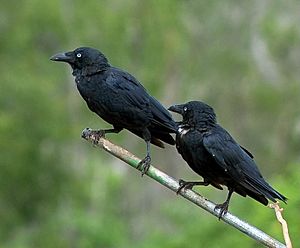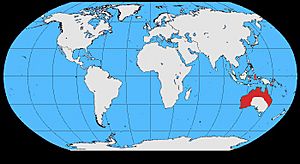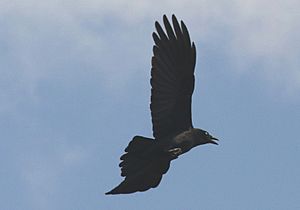Torresian crow facts for kids
Quick facts for kids Torresian crow |
|
|---|---|
 |
|
| Conservation status | |
| Scientific classification | |
| Genus: |
Corvus
|
| Species: |
orru
|
 |
|
The Torresian crow (Corvus orru) is a smart black bird. People also call it the Australian crow or Papuan crow. It belongs to the crow family and lives in northern and western Australia. You can also find it on islands near Australia, like parts of Indonesia and Papua New Guinea. This crow has black feathers, a black beak, and a black mouth. Its eyes are white, which is a special feature. The feathers on its head and neck are white at the base. The Torresian crow is a bit bigger than the little crow and has a stronger beak.
Contents
About the Torresian Crow's Name
A French bird expert named Charles Lucien Bonaparte first described the Torresian crow in 1850. The exact meaning of its scientific name, orru, is not fully known. It might come from a name used in Papua New Guinea.
There are three main types, or subspecies, of the Torresian crow:
- C. o. latirostris: Found in the eastern Lesser Sunda Islands.
- C. o. orru: Lives in the Maluku Islands, New Guinea, and nearby islands.
- C. o. cecilae: Found across western, central, and northern Australia.
What Does the Torresian Crow Look Like?
The Torresian crow is a large bird, about 48–53 centimeters (19–21 inches) long. It's similar in size to the European carrion crow. It has a strong beak and slightly longer legs. Its feathers are shiny black on its back and dull black on its chest. The tail is wide and has a distinct square shape. The beak, legs, and feet are dark gray.
A special feature of the Torresian crow is its white eyes with a thin blue ring. This helps tell it apart from many other crows. Also, the feathers at the base of its head and neck are white. You can see these white parts when the bird ruffles its feathers. When a Torresian crow lands, it often shuffles its wings. Young crows have brown eyes instead of white until they are about nine months old.
It's easy to mix up the Torresian crow with the Australian raven. They look very similar! But you can tell them apart by their calls. Each bird has its own unique sound.
Where Do Torresian Crows Live?
Torresian crows live in many places. They are found all over Australia, Papua New Guinea, and some islands in Indonesia. In Australia, they live from the tropical north down to places like Forster in New South Wales. They also live in parts of Western Australia.
These crows can live in almost any place as long as there is water nearby. You can find them in tropical rainforests, eucalyptus forests, open areas, beaches, swamps, and on islands. They also do well in places where people live, like farms, towns, and cities.
On farms in northern Australia, Torresian crows are very common. Farmers sometimes see them as pests because they can damage crops. They eat things like sweetcorn, peanuts, wheat, and many kinds of fruit. In cities and towns, many Torresian crows live happily. In the dry parts of central Australia, they are less common. They mostly stay near places with permanent water.
How Torresian Crow Populations Are Growing
Why More Crows Are Appearing
Like many crows, the Torresian crow is very good at adapting to different places. Their numbers are growing in Australia. This might be because there are more farms in dry areas and more cities being built. Studies show that between 1993 and 2004, Torresian crows started living in more cities and further south into dry parts of central Australia.
As Australian cities grow, natural forests are often replaced by suburbs and parks. This change has helped Torresian crows spread. In one study in South-East Queensland, the number of Torresian crows went up by about 40%. In Brisbane, there are so many crows that their loud calls at night sometimes bother people.
Crows in Rural Areas
The number of Torresian crows is also growing in country areas. More land being used for farming probably helps this. On farms, crows often gather in large groups. Since they need water to survive, you see big groups of crows in places with more rain, like the tropics and eastern Australia.
Even though they are spreading, there are still fewer crows in very dry areas. This is because there isn't enough steady water. However, new irrigation systems and wells for farms might be giving them enough water to live in places they couldn't before.
How Crows Use City Life
Crows, including the Torresian crow, are good at using "edge habitats." These are places where different environments meet, like where a forest meets a city. This helps them use city growth to their advantage. They find lots of food from people and face less competition from other birds.
One reason Torresian crows do well in cities is their diet. They eat many different things. A lot of their food comes from cities, like roadkill. Human trash also gives them plenty of food that's easy to find. Also, when forests are replaced by lawns and parks, there are more insects, which crows also eat. Because there's so much food, crows don't fight much over it. Their large size also helps them get food easily, so smaller city birds don't compete with them much.
Another reason they thrive in cities is their nesting habits. They don't need much space to build their nests. This means many crows can live close together in cities. So, cities can support many more Torresian crows than country areas where food is harder to find.
As cities continue to grow in Australia, they create new homes for these crows. Even small new developments can give them more places to live and breed.
Torresian Crow Behavior
Like other crows, Torresian crows are very smart and can learn new things. They have been seen working together in teams to steal food from bigger birds. They also know how to eat poisonous animals without getting sick.
Torresian crows are large and can be aggressive. Female crows are often more aggressive. They usually dominate most other birds, except for large birds of prey and the Australian magpie. They have been seen attacking bigger birds of prey, like wedge-tailed eagles and owls, to protect their nests or territory. Smaller birds, like willie wagtails, will also attack crows to protect their nests. Noisy miners and Australian magpies are some of the few birds that can successfully drive Torresian crows out of their areas.
From January to August, large groups of crows gather and travel around farms, forests, and city suburbs. These groups include crows of all ages. But from September to December, many crows leave these groups to find a partner and build a nest. The traveling groups become much smaller, with mostly young and old crows left. Each pair of crows usually returns to the same nesting spot every year.
What Do Torresian Crows Eat?
Torresian crows are omnivores, meaning they eat both plants and animals. Their diet changes depending on where they live. Crows in cities eat more food related to humans. Crows in natural areas mostly eat insects, berries, and dead animals. They have also been seen eating fish on beaches, roadkill, fruit, grains, small birds, and rodents.
In northern Australia, Torresian crows have learned a clever way to eat the poisonous cane toad. They flip the toad onto its back and hit it with their strong beak. This kills the toad without getting the poison from its skin. The crows then only eat the toad's insides and part of its legs, avoiding the poison. This special way of eating is passed down from one crow to another.
Torresian Crow Reproduction
The main time for breeding is from August to January. Most eggs are laid in September and October. The crows build a stick nest high up in a tree, usually a eucalypt tree. Sometimes, they choose other places like power poles or tall buildings.
The female crow lays two to four eggs. She sits on them for about twenty days. Then, the male helps her raise the chicks for about forty days until they can leave the nest. Young Torresian crows stay with their parents for several months after they learn to fly. After that, they join the traveling groups of crows.
Torresian crows are very protective of their nests. They will aggressively dive-bomb animals like goannas, snakes, and birds of prey. They might also swoop at dogs, cats, and even humans to defend their nest. However, they are not as aggressive as some other birds, like Australian magpies.
What Does the Torresian Crow Sound Like?
The Torresian crow's voice is quite different from the Australian raven. While they might make a loud, strong "Fark! Fark!" call like the raven, they often have a more nasal, metallic clattering sound like "uk-uk-uk-uk-uk" or "ok-ok-ok-ok." Sometimes they make an "Ar-ar-argh" sound, which can go up in pitch, a bit like a cat's meow. They might make these sounds after a standard call or by themselves.
See also
 In Spanish: Cuervo de Torres para niños
In Spanish: Cuervo de Torres para niños



